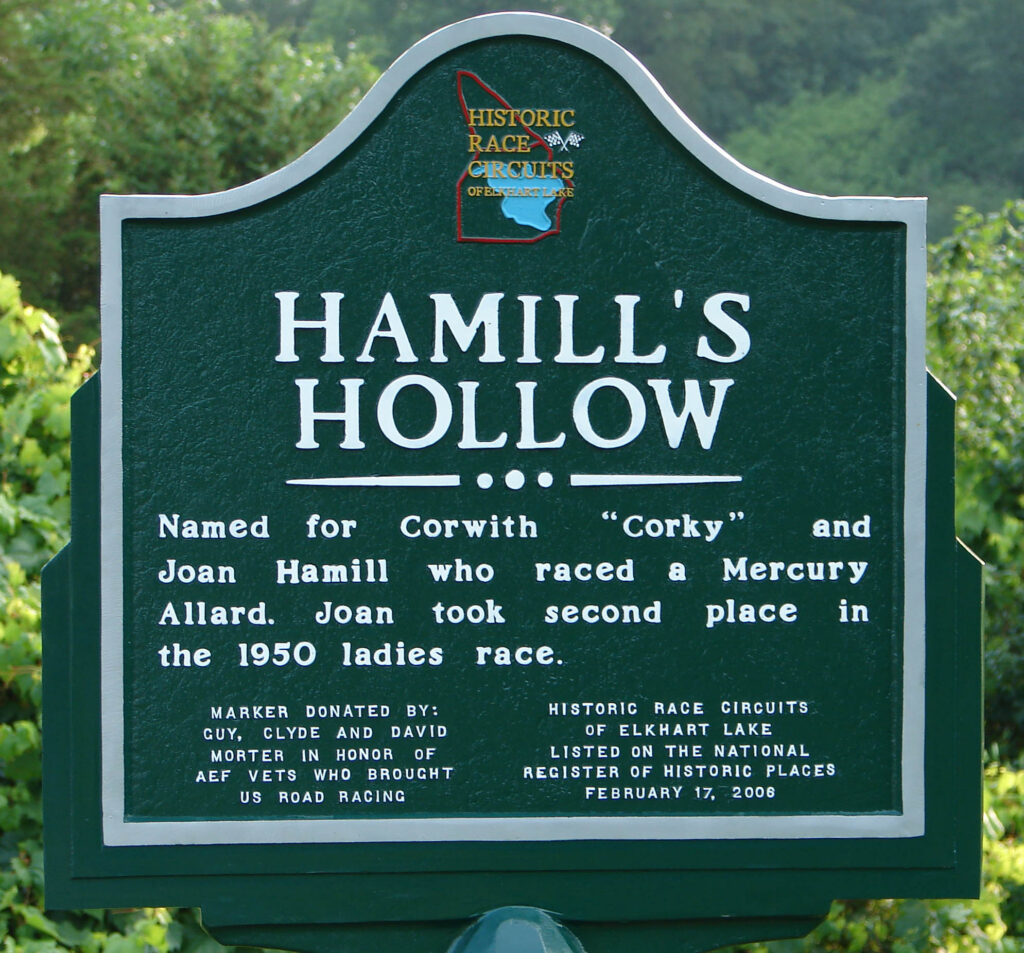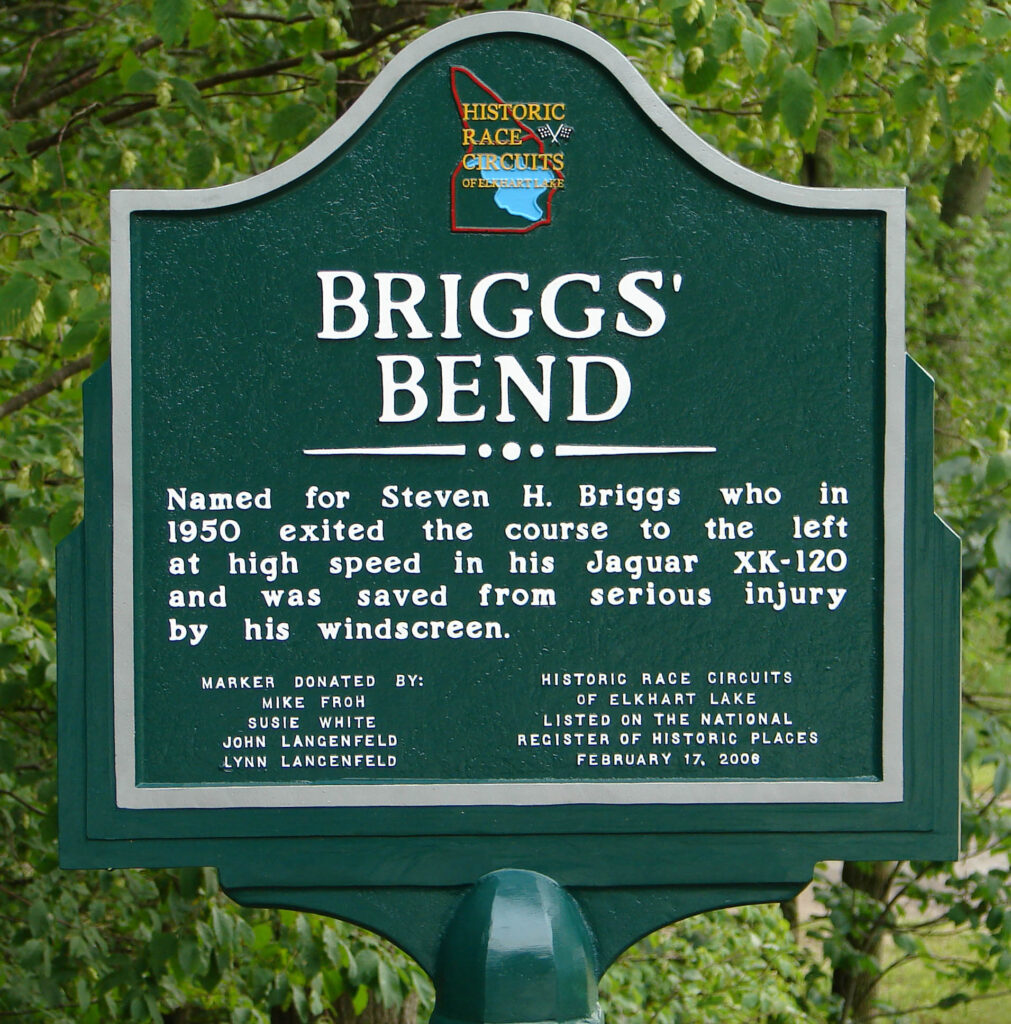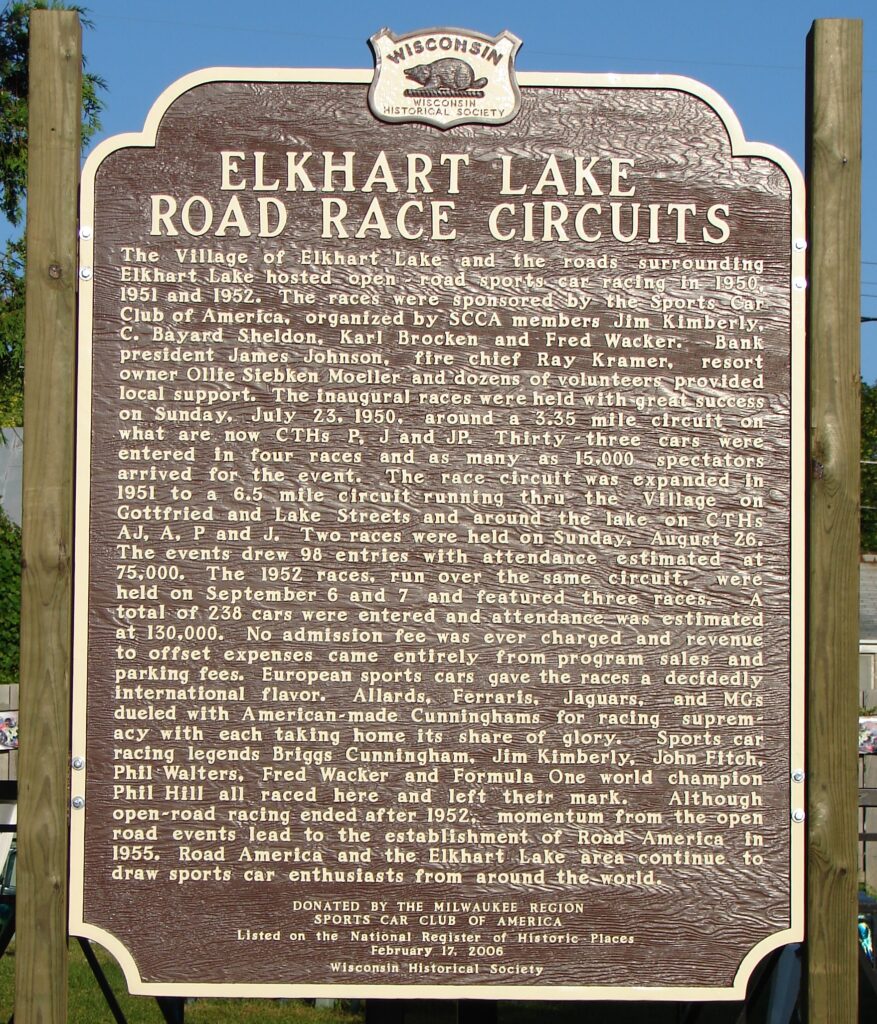The Elkhart Lake Historic Race Circuits refers to those Sheboygan County public roads used for organized amateur sports car races held in 1950, 1951, 1952 located in and around the Village of Elkhart Lake, Wisconsin. (The Village is located in Sheboygan County west of the city of Sheboygan and north of the city of Plymouth.) Take HWY 23 to HWY 67. Follow HWY 67 north past Road America and into the Village. In the Village, turn west on Rhine Street to the Village Square (see map).
To experience the 1950 race circuit start at Marker 6 and drive north on HWY P continuing clockwise on HWY J to HWY JP to the finish line at Marker 6. To experience the 1951/1952 race circuit start at Marker 1 on HWY J just south of the 5 way exchange at the Quit Qui Oc golf club house, continue clockwise south to County HWY A and continue on “A” to HWY “P” north to HWY “J” then south to the finish line Marker 12.
Drive around the track and click on any of the 14 signs to get a description of the history of the naming of the sign.

Wacker’s Wend (1)
“Wacker’s Wend” was named for Fred G. Wacker Jr. a man of many interests… a Naval Aviation veteran of WWII, he was a part time musician, a successful businessman, a motorcycle collector and a race car driver. While still in his twenty’s Fred was appointed president of Ammco Tools Inc., the business founded by his father in 1922 and continued in that capacity for 38 years. Ammco manufactured brake lathes and other tools used in the auto industry for brake service and wheel-alignment. He also founded Liquid Controls Corp. in 1954 that specialized in precision liquid-measurement equipment. A jazz drummer in college, he organized and led two bands that played at society functions and the dance venues in and around Chicago.
Fred Wacker was an active leader in the SCCA. He founded the Chicago Region in the Fall of 1948 and served as its’ first Regional Executive. He was elected as National Vice President of the SCCA in 1951 and was elected President in 1952. When the closing of public roads race circuits threatened the future of sports car racing in America, Fred, (with a little help from General Curtis LeMay), solved the problem by moving SCCA sanctioned races onto air-bases.
Fred’s racing career spanned eight years from 1949 to 1956 and included nearly fifty races. He raced at the 1951 Le Mans 24-hour endurance race as a member of the Cunningham Team and raced in the 1953-54 Formula 1 Grand Prix series with the Gordini Team. At Elkhart Lake, he entered the 1950 over 1500 race for experienced drivers and drove Jim Kimberly’s Healey Silverstone to 2nd place. He missed the 1951 Elkhart Lake races but in 1952 he was back at the Elkhart Lake races with a highly modified Cadillac-Allard J2. Unfortunately, he encountered mechanical problems and completed only13 laps.

Hamill’s Hollow (2)
“Hamill’s Hollow” was named for Corwith “Corky” and Joan Hamill. Corky was Treasurer of the Elgin Watch Company sponsor of the Borg-Warner trophy given to the Indianapolis 500 winner each year. He served as president of the Chicago Zoological Society and was described as one of Chicago’s greatest civic leaders. Joan was a prominent competitive equestrian rider who served on the board of the US Equestrian Team. Joan and Corky were among the founding members of the Chicago Region and Corky was the Race Chairman for the 1950 races in Elkhart Lake. In 1951, he was the Chicago Region’s second Regional Executive. He founded the popular regional publication PISTON PATTER, shared with the Milwaukee Region. Corky also served as National Treasurer of the SCCA.
Both Corky and Joan raced in their “family” 1948 Allard K1, a four place Tourer with a Mercury engine. Between them they participated in thirteen events between 1949 and 1953. At the 1950 Elkhart Lake races, Corky raced in the over 1500cc Novice event finishing in 4th place and Joan raced in 1950 Ladies race where she finished 2nd. In 1951 Corky raced in the Novice Event where he finished 1st in class and 5th overall. As the Mercury-Allard was getting a little tired, they did not race at Elkhart Lake in 1952. Switching to a Jaguar XK120 they both raced and rallied in 1953.
Schoolhouse Straight (3)
The “Schoolhouse Straight” is a flat, straight mile long section of CTY A, the southern leg of the 1951-52 circuit, that begins at the exit from “Hamills’ Hollow” and ends at the junction of CTY roads A and P (“Kimberly’s Korner”). It is named for the former Joliet elementary school used for public education until 1958, now converted to a private residence. The school is located on the south side of CTY A approximately one third of the way down the straight. It was the fastest part of the 1951-52 circuit where the more powerful cars could reach speeds in excess of 100mph. Not fast by today’s race car standards but mighty fast back then.

Kimberly’s Korner (4)
“Kimberly’s Korner” was named for James H. “Jim” Kimberly the grandson of John A. Kimberly, one of the four founders of the Kimberly-Clark Corporation. A graduate of MIT, he was a WWII Navy veteran and served in various management positions with Kimberly-Clark for 37 years. He was a well-known socialite often seen in the company of celebrities and movie stars. Kimberly loved racing; sailboats, iceboats, airplanes, and most of all sports cars. A founding member of the Chicago Region of the SCCA, he played an instrumental role in bringing open road sports car racing to the Midwest. When the Region’s members began a search for a potential midwestern racing location Kimberly, having been raised in nearby Neenah, suggested Elkhart Lake and arranged a fly over to survey the roads around the Village from the air. The rest, of course, is history.
Kimberly raced in sports car for ten years from 1950 to 1958 entering more than eighty races. He owned and raced many sports cars during his career but was mainly known for his love of Ferraris of which he owned nine. At Elkhart Lake he was one of the few who raced in all three years. He entered and won the 1950 60-mile Main Event for experienced drivers in his Ferrari 166 MM Barchetta. In the 1951 Main Event he entered and raced a Ferrari 340 America but did not finish when the clutch gave out. He was back again in 1952 for the 200-mile race for the Elkhart Lake Cup race, again in the Ferrari 340 America but again failed to finish. Kimberly remained involved in racing beyond 1958 sponsoring the Jack Brabham-piloted, one-of-a-kind Kimberly-Cooper T-54 at Indianapolis in 1961 and serving as president of the SCCA and Grand Marshal at a variety of races and concours events.

Dicken’s Ditch (5)
“Dickens’ Ditch” was named for Robert Sidney “Sid” Dickens. Sid was a self-taught packaging designer who founded of the Dickens Design Group in 1931. Sid had earned a national reputation for design originality and problem solving. Sid wasn’t at Wacker’s gathering that founded Chicago Region of SCCA, but was among the Region’s earliest members. The Region benefitted greatly from the Dickens’ design skills. Between them Sid and son Bob designed the logo for PISTON PATTER, the Region’s newsletter, the program covers used in 1951 and 1952 and the 1951-52 circuit maps. The maps were the first to show the alliterative named locations chosen by the race organizers. In 1954 Sid was elected the clubs fifth Regional Executive. He was responsible for the pit stewards for the first races at Road America in 1955. As the editor of PISTON PATTER in 1956 and 1957 he developed the newsletter into a work of art with a longitudinal format and featuring superb graphic design.
Sid raced from 1950 to 1956 entering twelve events in an MG-TC that he had originally purchased as a gift for his wife Ruth. Ruth was only 4” 8” and they had to put nine-inch blocks on the pedals so she could reach them. Sid and Ruth both raced in the 1950 races in Elkhart Lake. Sid ran in both the under 1500cc novice event finishing 6th and the Main Event for experienced drivers although the result is not known. Ruth, with pedal blocks in place, ran in the Ladies Race finishing 5th overall and 3rd in class. At Elkhart Lake in 1951 Sid and Ruth’s son, Bob Dickens, raced the MG-TC in the Novice Race finishing 15th overall and 6th in class. Sid ran the car in the Main Event for Experienced Drivers but completed only thirteen laps. As luck would have it, he overcooked the bend at the location named in his honor and ended up back end first in “Dickens Ditch” losing oil pressure and retiring early. The Dickens’ did not race at Elkhart Lake in 1952 but Ted Boynton in his Frazer-Nash Le Mans, had a momentary lapse in concentration during a practice lap and ended up in Dickens’ Ditch with a cockpit full of poison ivy and “blood” in his eyes. The “blood” turned out to be blueberry juice.
1950 Start/Finish Line (6)
The “1950 Start/Finish Line” marked the starting point of the 3.35-mile circuit north of the lake used for the 1950 sports car races. The Start/Finish line was located here in front of the Theal farm. The location was chosen for the long view both up and down CTY P, for the ample parking in the farm field on the west side of the road and the availability the Theal’s shade front yard for the timing stands. The pits lined the road on the east side between the yard and the road. Spectators, estimated at nearly 5000, lined the high banks on the west side of the road seemingly only a few feet from the then exotic, newfangled sports cars.
The Marsh Turn (7)
The “Marsh Turn” was named for its proximity to the Sheboygan Marsh located to the west and visible from the turn. A run-off escape road was mowed into the open area on the north side of the turn and more than a few competitors tried to take the tricky corner a little too fast and found themselves in the run-off. The “Marsh Turn” was mistakenly identified as “Dickens’ Ditch” on the 6.5-mile circuit map used in the 1951 program but by 1952 the error was corrected and the “Dickens’ Ditch” location correctly identified. The “Marsh Turn” was the only named location common to all three years of open road sports car racing in Elkhart Lake.
Ted’s Turn (8)
“Ted’s Turn” was named for Charles “Ted” Boynton
Ted Boynton raced sports cars for nine years from 1950 to 1959 and entering forty-six events. He owned and raced an MG-TC but in the 1950 over 1500cc Novice Event he borrowed Jim Kimberly’s Healey Silverstone and drove it to first place. (The car was also raced by Sally Chapin in the Ladies Event and Fred Wacker in the Main Event finishing 1st and 2nd in their respective events). In 1951 Boynton purchased a Frazer-Nash Le Mans and entered the Main Event finishing 2nd in class 4 and 8th overall. In 1952 again in his Frazer-Nash he entered the 200-mile Main Event but his excursion into Dickens’ Ditch during practice bent the torsion bar and the car did not start.
Peck’s Alley (9)
“Peck’s Alley” was named for C. Cameron Peck whose family owned the Bowman Dairy Company, the largest home deliverer of dairy products in the Midwest. He was a vintage car collector who restored and displayed his collection in a converted auto dealership on Chicago’s north side. At its peak time his collection included 175 restored vehicles. He was the National President of the SCCA in 1950 and 1951 and was instrumental in helping Fred Wacker organize the SCCA’s Chicago Region. At Elkhart Lake he organized the vintage car parades and concours events that were part of the race weekend. He judged the Concours d’ Elegance events in all three years.

Briggs’ Bend (10)
“Briggs’ Bend” was named for Stephen A. (Steve) Briggs, the eldest son of Stephen F. Briggs co-founder of Briggs & Stratton and the founder of Outboard Marine where Steve was employed. Steve was an early member of the Chicago Region. Steve served as chairman of the Region’s Social Events Committee in 1952 and in 1954 was a member of the Region’s Membership Committee. Steve’s wife Joan was in charge of the ladies who handled the timing and scoring for the 1952 Elkhart Lake Races.
Steve owned both an MG-TC and a Jaguar XK120 but raced in only five events during his racing career. At Elkhart Lake he raced the MG-TC in the 30-mile Novice event for cars under 1500cc finishing in 8th place. He entered the XK120 in the 30-mile Novice event for cars over 1500cc event where he finished 3rd. Thus encouraged, he entered the 60-mile Main event for experience drivers. It was in the latter event that he failed to negotiate the dangerous downhill turn that now bears his name, exited the course passing under a barbed wire fence and was saved from serious injury when the wire was deflected over his head by the windscreen. Joan Briggs drove their MG-TC in the 1950 Ladies race where she finished 2nd in the under 1500cc class. Steve raced in Elkhart Lake for the last time in the 1951 Novice event for combined classes where he finished 8th overall and 4th in class driving his XK120. His off-course excursion in 1950 assured him of a place, albeit somewhat ignominious, in the sports car racing history of Elkhart Lake.
The Hard Right (11)
The Hard Right” was so named because in the 1950 races it was a difficult right-hand turn located at the end of a downhill run onto CTY P with a typical crowned contour giving the west side of the road an outside camber. The skinny tires and drum brakes of the era didn’t help. On the 1951 5.3-mile circuit map (that used CTY X) it would have been a sharp but less difficult turn off CTY P onto CTY X. Although the turn was the reverse of 1950, it was still a right turn and the name was used.
1951-52 Start/Finish Line (12)
The “1951-52 Start/Finish Line” was located at the junction of South Lake Street and Oak Street on the 5.3-mile circuit that used CTY X. However, at the 1951 drivers meeting it was determined that CTY X was too dangerous for racing. The race circuit was revised to a 6.5-mile race circuit extended to the Marsh Turn at the intersection of CTY’s P and J and 1951-52 start/finish line was moved to a new location on Gottfried Street slightly north of the Feed Mill. The timing stands were located on the east side of Gottfried Street, now a parking lot, and the pits were located alone the west side.
State Historical Marker (13)
After the Sheboygan County Highway Department announced plans to demolish and reconstruct parts of the historic circuits in 2002, opposition emerged and the HRC along with Road America took leading roles. Their objective was to preserve the circuits by obtaining listing on the National Register of Historic Places. In February of 2006 they were successful, and the Historic Race Circuits were recorded on the National Register by the Department of the Interior, making the circuit eligible for the placement of a Wisconsin State Historical Marker. Funds for the marker were donated by the SCCA’s Milwaukee Region who along with the Chicago Region jointly sponsored the open road sports car races in and around the village of Elkhart Lake.
The Hard Left (14)
“The Hard Left” is the sharp left turn on South Lake Street in front of Siebkens resort. It became a named location when the 1951-52 circuit was extended to the Marsh Turn and the CTY X leg was eliminated. At the location South Lake Street had a rather severe outside camber making the turn very difficult to take at race speed. Seeming to prove the point, in the 1952 Kimberly Cup race William Taylor's MG spun at “The Hard Left", plowed into the snow fencing hitting the people behind it, before being stopped by a telephone pole. Eight people were injured, none seriously, but it did show how little protection a barrier of snow fencing really was.
|
The original Start/Finish Line of the 1951 and 1952 races is located on Gottfried Street (CTH J) across from the old feed mill near the main intersection or Gottfried, Rhine and Lake Streets. The Wisconsin State Historical Marker is located on Lake Street between the Lake Street Cafe and the Paddock Club Restaurant. Stop at the Chamber of Commerce information kiosk and pick up a Historic Race Circuits brochure. It contains a map of the circuits and interesting historical information regarding the named locations around the circuits.














